The importance of ink for large format printers
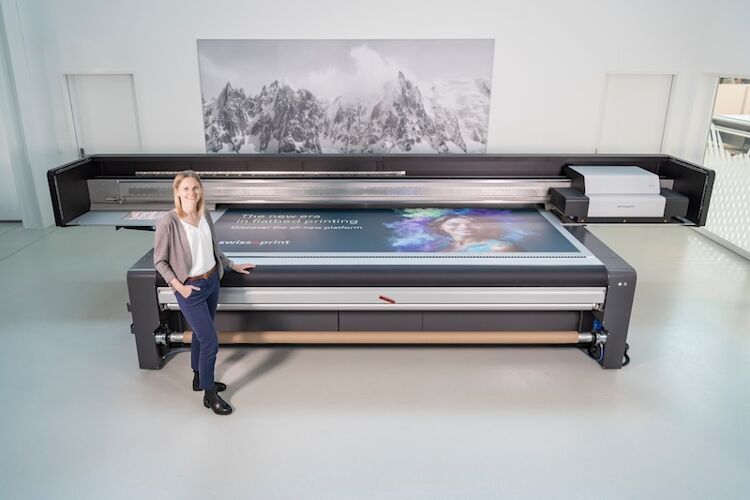
Ink is crucial for large format inkjet printers, influencing substrate compatibility, productivity, and cost. Nessan Cleary discusses the three main types which include UV-curable ink, latex ink and eco-solvent ink. Each ink type has specific strengths and weaknesses, making printers choice dependent on budget and intended applications.
All printing machines, including large format inkjet printers, are designed around the singular purpose of getting ink onto a substrate and fixing it in place. All the other factors that influence how people choose a printer, including the range of substrates, the productivity and the overall cost, come from the choice of ink. So understanding how ink works is critical when choosing the most suitable printer technology to invest in.
Inkjet ink faces a particular challenge as it has to flow easily through the print system, and be jetted through very small nozzles, but then has to dry quickly enough to be wound onto a take up roll or sent straight to a cutting table. Naturally, the most important component within the ink is the pigment, finely ground solid particles that provide the colour. They can be organic, from a carbon base, or inorganic, from a mineral or metal.
In addition, inkjet inks also contain a number of additives, each chosen to add particular properties, such as humectants and wetting agents to help with the way the ink flows. This might also include dispersing agents, to keep the pigment evenly distributed throughout the ink, as well as biocides, to prevent microbial growths, or defoamers to limit air bubbles from forming.
There are three main types of ink used in large format printing. Perhaps the most common of these is UV-curable ink. This ink is based around the chemical reaction between monomers, which control the viscosity, and oligomers, which help bind the ink to the media. Apart from the coloured pigment, it also contains a photo initiator, and when the ink is exposed to ultra violet light, the photo initiator triggers the elements within the monomers and oligomers to crosslink, so that they harden or cure into a film and bond with the substrate. This curing is almost instantaneous so that there is no need for any further drying, and the graphic can be sent straightaway for any further finishing processes.
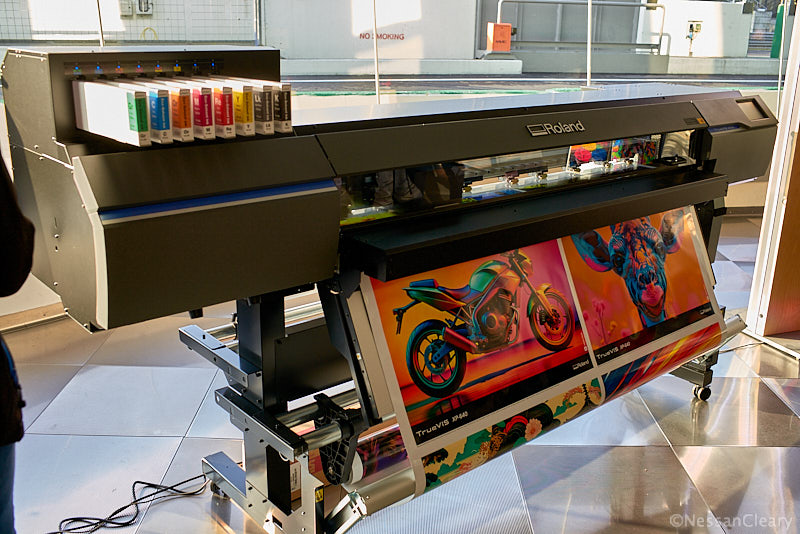 Roland's TrueVis XP640, seen here with eight colours, can also be set up with two sets of CMYK. ©Nessan Cleary
Roland's TrueVis XP640, seen here with eight colours, can also be set up with two sets of CMYK. ©Nessan Cleary
UV-curable ink can be expensive, mainly because of the complexity of the different components, particularly the photo-initiators. The ink sits on the media surface and will bond with most types of substrates though some UV inks struggle with very smooth surfaces such as glass. Different formulations of UV ink are used to exploit particular characteristics. Thus the ink for a flatbed printer will generally cure to a very robust finish that is able to withstand weathering and abrasion but is mainly suitable for rigid substrates. UV ink for rollfed printers is more flexible but does not generally cure to the same degree of toughness. Most UV printers produce a matte finish but some will also offer a glossy effect that is usually achieved by varying the curing time.
Most UV printers now use LED arrays as their light source, which is considerably more sustainable than the older mercury vapour lamps. This ink is mostly safe to work with though you should avoid direct skin contact.
Eco-Solvent
Solvent ink is one of the oldest types of large format ink though the modern formulations are referred to as eco-solvent. The ‘eco’ in the name originally referred to economy as they were cheaper than full solvent inks. However, most people have assumed that this referred to ecology and that this ink is more sustainable, and most vendors are now happy to go along with that for obvious marketing reasons.
Eco-solvent has now replaced most other forms of solvent ink because of regulatory pressure covering the use of various solvents. This is due to health hazards as solvents generally dry by evaporating into the atmosphere, in the process release volatile organic compounds, or VOC, that can cause respiratory problems. Most eco-solvent inks have very low emissions of VOC though it’s still recommended to ensure a good airflow around them, even if that’s only leaving a window open.
Solvent inks work by melting the surface layer of a substrate so that the pigments can penetrate further into the material, which makes for a very durable graphic. Eco-solvents are not as aggressive as full solvent inks, which limits the range of media they will work with. Another issue is that these printers require heating and fans to help evaporate the solvent, which uses energy and risks damage to some heat sensitive materials. However, there is a good range of suitable media available and the prints do last a long time, including for outdoor signage.
This ink generally has good colour saturation and gloss so that the prints appear quite vibrant. Moreover, eco-solvent printers and inks are much cheaper than UV-curable printers so they are still very common amongst smaller bureaux. They are only suitable for flexible media but are very effective with vehicle graphics.
Resin or latex ink
There are several families of water-based inks, including resin ink, which is rapidly becoming more common. Resin ink is also known as latex ink, and has been championed in wide format printing by HP as a water-based ink that offered good sustainability while still being suitable for the rigours of outdoor signage.
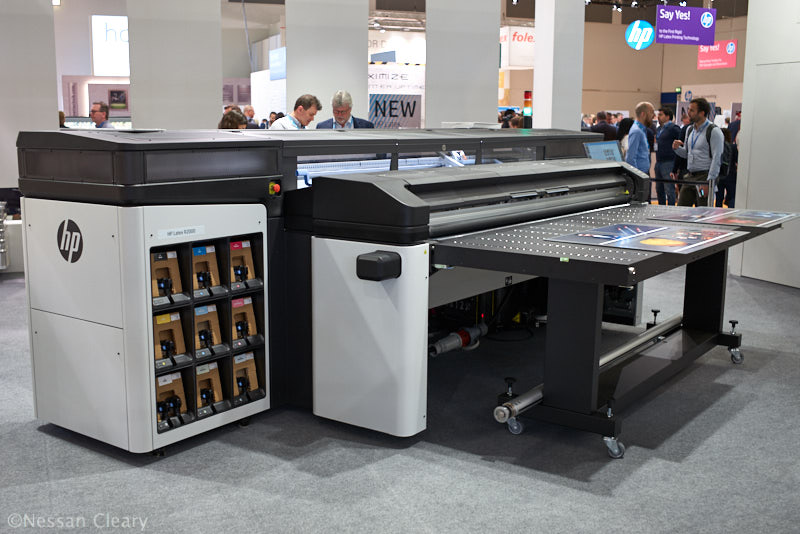 HP 's first latex printer capable of printing to rigid materials is this R2000 hybrid. ©Nessan Cleary
HP 's first latex printer capable of printing to rigid materials is this R2000 hybrid. ©Nessan Cleary
Resin ink usually relies on an optimiser which acts like a primer and sits on top of the media surface. The ink is then dropped precisely on top of the optimiser, which holds the ink firmly in place. The pigment is encapsulated in a resin and this resin melts when heated to bind the pigment to the substrate. As with UV-curable inks, resin ink will work with a wide range of different materials, both porous and non-porous including vinyl, banner, film, canvas, textiles and wallpaper and can be used for both interior and exterior signage applications including vehicle graphics.
The main advantage in terms of wide format graphics is that there is no odour associated with them so that the prints can be used in moresensitive environments such as hospitals and schools as well as retail point of sale.
Unfortunately, since resin ink is water-based, it does come with the fundamental disadvantage that the water content must be dried out, meaning that a certain amount of heat has to be used. This in turn can limit the substrate range as some media are quite sensitive to heat. And of course more heat also leads to higher energy consumption - and therefore cost - for the heating elements. That said, the latest generation of inks use less heat and less energy.
In addition, you will also find some large format printers that use aqueous ink, which are mainly targeted at the fine art, photography and proofing markets and are really only suitable for indoor display. And of course there are large format textile printers, but these are best left to another story as textile printing is a class of its own.
Otherwise, all three of these ink types - UV-curable, eco-solvent and resin or latex - are suitable for a broad range of display graphics applications, including outdoor signage. Between them they offer a good choice of pricing and footprint so the choice really comes down to which best suits your budget and planned applications.
Discover the latest innovations in inks and large format printing at FESPA Global Print Expo 2025, Europe's leading print and signage exhibition taking place from 6 - 9 May at Messe Berlin, Germany. It will showcase the most innovative products, visionary concepts, and latest developments in the future of print. Register to visit here and use promo code FESJ502 and only pay 25 euros for your entrance ticket.
Interested in joining our community?
Enquire today about joining your local FESPA Association or FESPA Direct
Recent news
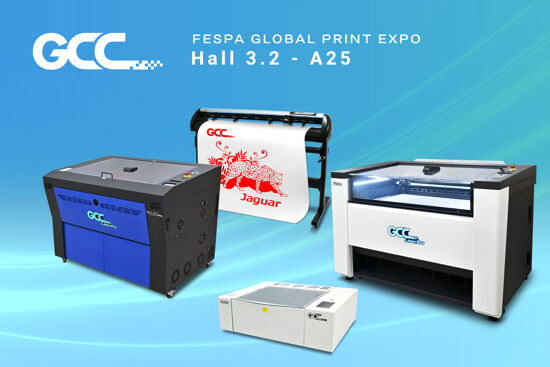
GCC LaserPro at FESPA 2025: Pioneering the Future of Speed and Precision
GCC, a leading front-end R&D company, established its brand, GCC LaserPro, to drive innovation in laser engraving and cutting solutions. We are excited to showcase our latest advancements at FESPA 2025 in Berlin!
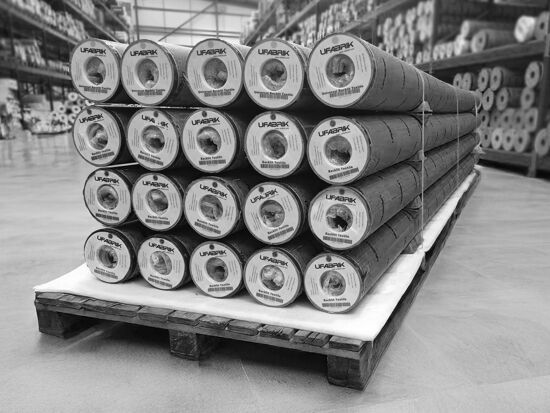
Why more print service providers are turning to consignment stock management
Robin East, Group Chief Commercial Officer at UFABRIK discusses how consignment stock management is gaining popularity in the print industry, offering improved cash flow and operational efficiency. It ensures on-site stock availability, enhancing customer service and reducing delivery times. This approach also promotes sustainability through consolidated shipments and fosters stronger supplier-customer relationships.
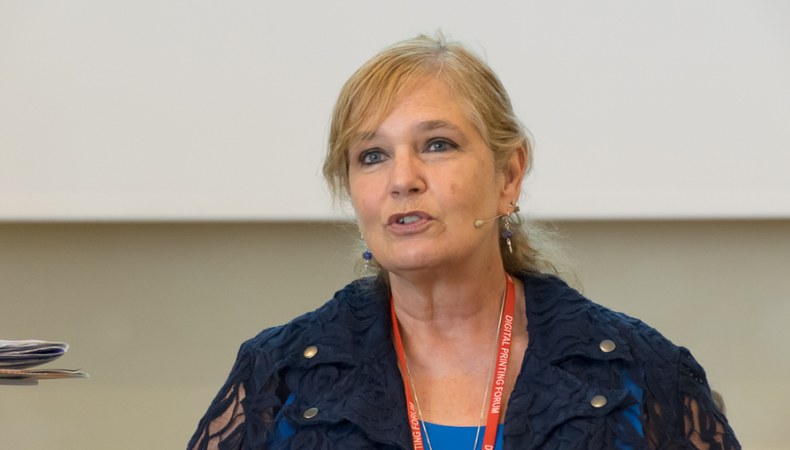.png?width=550)
Personalisation is a long-tail experience: how Variable Data Printing can drive years of engagement
Pat McGrew shares how Personalisation in print offers long-term engagement, not just one-off interactions. Using minimal data, tailored campaigns across formats like mail and signage can boost loyalty. GDPR compliance is key, requiring transparency and consent. Success stories demonstrate personalisation's power, making it a vital competitive edge.

Mimaki unveils new UV DTF technology and next-gen UV inks ahead of FESPA 2025
Mimaki Europe, a leading provider of industrial inkjet printers and cutting plotters, is set to showcase its first UV-DTF (UV curable, direct-to-film) printer, the UJV300DTF-75, at FESPA Global Print Expo 2025.